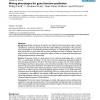Free Online Productivity Tools
i2Speak
i2Symbol
i2OCR
iTex2Img
iWeb2Print
iWeb2Shot
i2Type
iPdf2Split
iPdf2Merge
i2Bopomofo
i2Arabic
i2Style
i2Image
i2PDF
iLatex2Rtf
Sci2ools
BMCBI
2008
2008
Mining phenotypes for gene function prediction
Background: Health and disease of organisms are reflected in their phenotypes. Often, a genetic component to a disease is discovered only after clearly defining its phenotype. In the past years, many technologies to systematically generate phenotypes in a high-throughput manner, such as RNA interference or gene knock-out, have been developed and used to decipher functions for genes. However, there have been relatively few efforts to make use of phenotype data beyond the single genotype-phenotype relationships. Results: We present results on a study where we use a large set of phenotype data
Annotation | BMCBI 2008 | Gene | Phenotype |
| Added | 09 Dec 2010 |
| Updated | 09 Dec 2010 |
| Type | Journal |
| Year | 2008 |
| Where | BMCBI |
| Authors | Philip Groth, Bertram Weiss, Hans-Dieter Pohlenz, Ulf Leser |
Comments (0)

